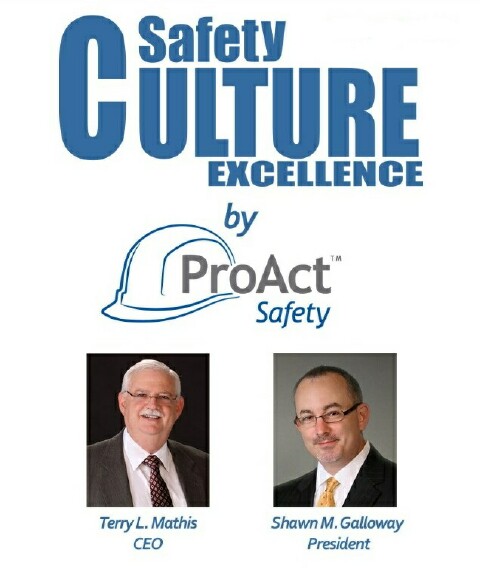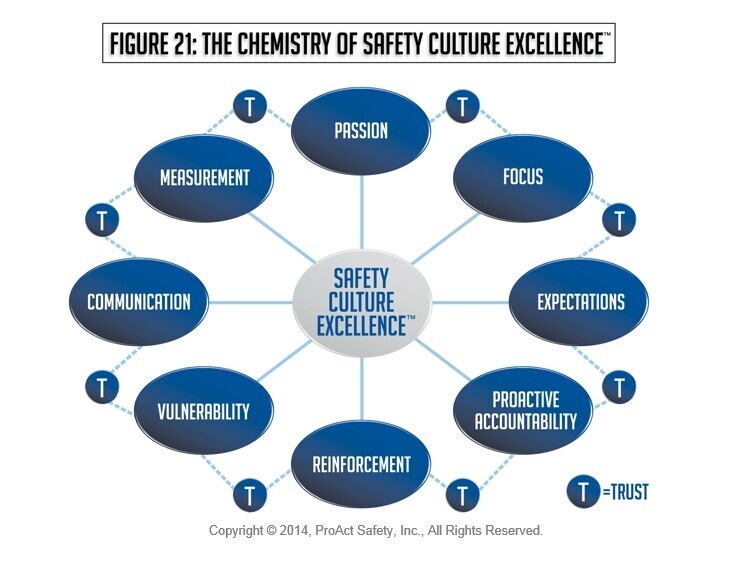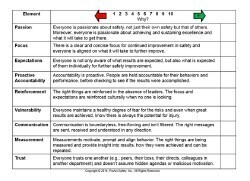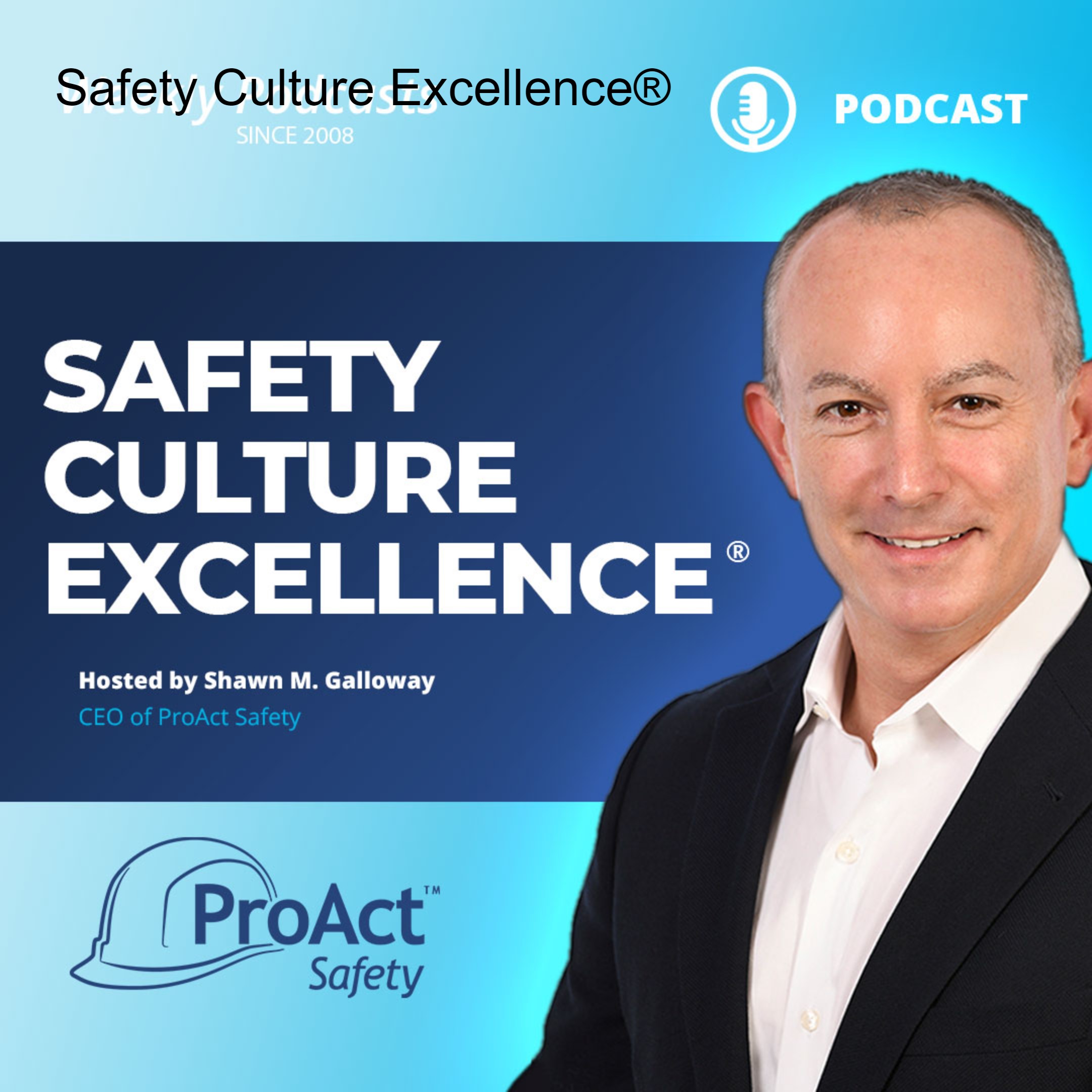Episodes

Monday Jul 21, 2014
346 - Measuring Safety Culture Maturity A Better Way
Monday Jul 21, 2014
Monday Jul 21, 2014
This is an audio version of the previously published blog on this topic:
Forget the old ways of measuring safety culture maturity. There
is a new, more effective way to measure cultural maturity and it starts
with looking at the chemistry.

In consulting globally with many of the best in safety performance and culture, nine elements (see the picture with this post) have been identified as most important foci to establish the chemistry which facilitates the necessary climate for a culture of safety excellence to grow. Through consulting engagements and workshops, these nine elements have been successfully leveraged and measured to help organizations identify both their starting point baseline, and also to strategically prioritize which elements to focus on to advance the capabilities of their safety culture.

If you have read my work, participated in any of my workshops or keynote presentations or worked with me directly, you will know I work hard to always provide more take-away tools than motivational fluff. If I was able to provide the framework to facilitate the internal dialogue in article format, I would.
To assist you on your journey to safety excellence, I would like to share this tool with you. To obtain a copy for your internal use, send an email to info@proactsafety.com with the subject of Please Send Chemistry of SCE and our staff will respond at our earliest opportunity.
Cultures will always influence the beliefs and behaviors of employees and contractors as they join the group. You can either manage the chemistry, climate and culture, or the results in any area of operational performance will be managed by them. I invite you to start the conversation to strategically enhance the safety aspect of your company culture and measure your progress by contributed value, not just the lowering of injury rates.
-------------------
Shawn M. Galloway is the President and COO of ProAct Safety. He writes (and tweets:@safetyculture) about his work helping organizations in all industries to achieve and sustain excellence in their culture and performance. He resides near Houston, Texas with his wife and three children.

Wednesday Jul 16, 2014
Culture and Customizing
Wednesday Jul 16, 2014
Wednesday Jul 16, 2014
Some of the old safety programs and processes are still alive and well in certain organizations. When I examine how they have survived so long I almost always find that the program has been modified and customized. The organization is not still doing the process like they were taught, they have “made it their own” over the years using the basic concept(s) but modifying the details.
Another term for customizing might be “culturizing.” When a group of people not only use a methodology but modify it to fit their specific needs and standards, it truly becomes a part of the organizational culture. It is no longer solely the brainchild of the originator, but the adopted child of the group. As it permeates the group it becomes a part of the culture that is shared and handed down.
Such processes never become outdated because they are fluid and the group can evolve them to meet changing needs and challenges. Perhaps it should be the goal of every safety program or process to have this kind of flexibility built in as a sustainability tool. If this were the case, there would likely be fewer flavors of the month and more tools to build strong safety cultures.
-Terry L. Mathis
For more insights, visit www.ProActSafety.com
Terry L. Mathis is the founder and CEO of ProAct Safety, an international safety and performance excellence firm. He is known for his dynamic presentations in the fields of behavioral and cultural safety, leadership, and operational performance, and is a regular speaker at ASSE, NSC, and numerous company and industry conferences. EHS Today listed Terry as a Safety Guru in ‘The 50 People Who Most Influenced EHS in 2010, 2011 and 2012-2013. He has been a frequent contributor to industry magazines for over 15 years and is the coauthor of STEPS to Safety Culture Excellence, 2013, WILEY.

Monday Jul 14, 2014
345 - When Site Managers Undo Corporate Safety
Monday Jul 14, 2014
Monday Jul 14, 2014
Greetings everyone, this podcast recorded while in Banff, Alberta. I’d like to share an article Terry Mathis wrote that was published May 2014 in EHS Today Magazine. The published article can either be found on the magazine’s website or under Insights at www.ProActSafety.com.
I hope you enjoy the podcast this week. If you would like to download or play on demand our other podcasts, please visit the ProAct Safety’s podcast website at: http://www.safetycultureexcellence.com. If you would like access to archived podcasts (older than 90 days – dating back to January 2008) please visit www.ProActSafety.com/Store. For more detailed strategies to achieve and sustain excellence in performance and culture, pick up a copy of our book, STEPS to Safety Culture Excellence - http://proactsafety.com/insights/steps-to-safety-culture-excellence
Have a great week!
Shawn M. Galloway
ProAct Safety

Wednesday Jul 09, 2014
Measuring Safety Culture Maturity: A Better Way
Wednesday Jul 09, 2014
Wednesday Jul 09, 2014
Forget the old ways of measuring safety culture maturity. There is a new, more effective way to measure cultural maturity and it starts with looking at the chemistry.

In consulting globally with many of the best in safety performance and culture, nine elements (see the picture with this post) have been identified as most important foci to establish the chemistry which facilitates the necessary climate for a culture of safety excellence to grow. Through consulting engagements and workshops, these nine elements have been successfully leveraged and measured to help organizations identify both their starting point baseline, and also to strategically prioritize which elements to focus on to advance the capabilities of their safety culture.

If you have read my work, participated in any of my workshops or keynote presentations or worked with me directly, you will know I work hard to always provide more take-away tools than motivational fluff. If I was able to provide the framework to facilitate the internal dialogue in article format, I would.
To assist you on your journey to safety excellence, I would like to share this tool with you. To obtain a copy for your internal use, send an email to info@proactsafety.com with the subject of Please Send Chemistry of SCE and our staff will respond at our earliest opportunity.
Cultures will always influence the beliefs and behaviors of employees and contractors as they join the group. You can either manage the chemistry, climate and culture, or the results in any area of operational performance will be managed by them. I invite you to start the conversation to strategically enhance the safety aspect of your company culture and measure your progress by contributed value, not just the lowering of injury rates.
-------------------
Shawn M. Galloway is the President and COO of ProAct Safety. He writes (and tweets:@safetyculture) about his work helping organizations in all industries to achieve and sustain excellence in their culture and performance. He resides near Houston, Texas with his wife and three children.

Monday Jul 07, 2014
344 - Safety Excellence Focus Trumps Fanaticism
Monday Jul 07, 2014
Monday Jul 07, 2014
Greetings everyone, this podcast recorded while in Denver, CO. I’d like to share an article I wrote that was published June-July 2014 edition of BIC Today Magazine. The published article can either be found on the magazine’s website or under Insights at www.ProActSafety.com.
I hope you enjoy the podcast this week. If you would like to download or play on demand our other podcasts, please visit the ProAct Safety’s podcast website at: http://www.safetycultureexcellence.com. If you would like access to archived podcasts (older than 90 days – dating back to January 2008) please visit www.ProActSafety.com/Store. For more detailed strategies to achieve and sustain excellence in performance and culture, pick up a copy of our book, STEPS to Safety Culture Excellence - http://proactsafety.com/insights/steps-to-safety-culture-excellence
Have a great week!
Shawn M. Galloway
ProAct Safety

Wednesday Jul 02, 2014
Blue Ocean or Bomb the Island: Innovation vs. Provocation
Wednesday Jul 02, 2014
Wednesday Jul 02, 2014
A controversy has almost always attracted attention. That is why some constantly try to provoke an argument about some aspect of a practice. The idea of questioning the status quo is a legitimate issue, but simply challenging the establishment does not advance the cause. True advancement comes from trying the new, not from simply attacking the old.
There is a parallel between the provocateur and the old dichotomous thinking expressed in the saying, “If it ain’t broke don’t fix it!” The idea that everything fits into either the fixed or broken category is limited, two-dimensional thinking at best. The innovative approach does not categorize ideas or practices, but seeks to advance them. In true innovation, there are not even “best practices” because such thinking might stop future progress. There are better practices that will be replaced by even better practices as our wits sharpen and our organizations embrace transformational thinking.
Blue ocean thinking opens whole new avenues of opportunity for the landlocked. Provocation tends to bomb the island on which we live without discovering a new one.
-Terry L. Mathis
For more insights, visit www.ProActSafety.com
Terry L. Mathis is the founder and CEO of ProAct Safety, an international safety and performance excellence firm. He is known for his dynamic presentations in the fields of behavioral and cultural safety, leadership, and operational performance, and is a regular speaker at ASSE, NSC, and numerous company and industry conferences. EHS Today listed Terry as a Safety Guru in ‘The 50 People Who Most Influenced EHS in 2010, 2011 and 2012-2013. He has been a frequent contributor to industry magazines for over 15 years and is the coauthor of STEPS to Safety Culture Excellence, 2013, WILEY.

Monday Jun 30, 2014
343 - What is Your Safety Elevator Pitch?
Monday Jun 30, 2014
Monday Jun 30, 2014
Greetings everyone, this podcast recorded while in my home in Texas. I’d like to share an article I wrote that was published May 2014 in Professional Safety Magazine. The published article can either be found on the magazine’s website or under Insights at www.ProActSafety.com.
I hope you enjoy the podcast this week. If you would like to download or play on demand our other podcasts, please visit the ProAct Safety’s podcast website at: http://www.safetycultureexcellence.com. If you would like access to archived podcasts (older than 90 days – dating back to January 2008) please visit www.ProActSafety.com/Store. For more detailed strategies to achieve and sustain excellence in performance and culture, pick up a copy of our book, STEPS to Safety Culture Excellence - http://proactsafety.com/insights/steps-to-safety-culture-excellence
Have a great week!
Shawn M. Galloway
ProAct Safety

Wednesday Jun 25, 2014
How Do You Define Production?
Wednesday Jun 25, 2014
Wednesday Jun 25, 2014
If you define production as products or services delivered and do not include safety in that definition, you are creating a dichotomy that will damage both production and safety. Production that injures those who produce it is most likely not the kind of production your organization wants. An accident (incident, injury – pick your preferred term) is a defect in your production process just as surely as a quality issue. If you develop a tolerance for poor quality or poor safety, you have developed a tolerance for poor production.
Organizations who achieve safety excellence do not make this distinction. They define production as safe and high quality products or services delivered. They manage safety and quality as a part of production rather than separate priorities. Workers who compromise any aspect of safety or quality have compromised production. The old ideas of production at any cost and sacrificing your body for the team are antiquated and counterproductive. If you still have these dichotomies in your organization, begin to improve by redefining what production is and what you expect from production workers.
-Terry L. Mathis
For more insights, visit www.ProActSafety.com
Terry L. Mathis is the founder and CEO of ProAct Safety, an international safety and performance excellence firm. He is known for his dynamic presentations in the fields of behavioral and cultural safety, leadership, and operational performance, and is a regular speaker at ASSE, NSC, and numerous company and industry conferences. EHS Today listed Terry as a Safety Guru in ‘The 50 People Who Most Influenced EHS in 2010, 2011 and 2012-2013. He has been a frequent contributor to industry magazines for over 15 years and is the coauthor of STEPS to Safety Culture Excellence, 2013, WILEY.

Monday Jun 23, 2014
342 - Is Winning or Losing a Safety Culture Habit?
Monday Jun 23, 2014
Monday Jun 23, 2014
Greetings everyone, this podcast recorded while in Auburn Hills, MI. I’d like to share an article I wrote that was published May 2014 in Occupational Health & Safety Magazine. The published article can either be found on the magazine’s website or under Insights at www.ProActSafety.com.
I hope you enjoy the podcast this week. If you would like to download or play on demand our other podcasts, please visit the ProAct Safety’s podcast website at: http://www.safetycultureexcellence.com. If you would like access to archived podcasts (older than 90 days – dating back to January 2008) please visit www.ProActSafety.com/Store. For more detailed strategies to achieve and sustain excellence in performance and culture, pick up a copy of our book, STEPS to Safety Culture Excellence - http://proactsafety.com/insights/steps-to-safety-culture-excellence
Have a great week!
Shawn M. Galloway
ProAct Safety

Wednesday Jun 18, 2014
Safety Overtraining
Wednesday Jun 18, 2014
Wednesday Jun 18, 2014
The medical profession is concerned that the overuse of antibiotics is causing strains of bacteria to become resistant and patients to be less receptive to the most-used medications. The same thing can happen to safety when training is overused or misused. Workers can tune it out and workplace accidents can become resistant to it.
Regulatory mandates require a quantity and content of safety training, but more or less neglect the quality of that training. This has resulted in some of the dullest, most monotonous and least-effective safety training that the world has ever seen. The use of Computer-Based Training (CBT) has further aggravated the problem. Required safety training in many organizations is viewed at best as a necessary evil by any worker who has taken it more than two times. When safety training quits being an asset to the organization, it can damage the effectiveness of other safety-improvement efforts as well.
If this state of safety training were not bad enough, some organizations actually use training or re-training as a punishment. When a worker is injured or is caught failing to follow a safety rule, they can be sent back to training. The assumption that the training did not impact worker behavior is valid enough, but the assumption that more of the same, ineffective training will magically work the second time is borderline absurd. Also, if safety re-training is viewed as a form of punishment, how will that impact the overall perception of the value of safety training?
Organizations need to view safety training as a tool to meet worker needs rather than a painful requirement that can be re-used as punishment. The opportunities for good quality safety to improve safety performance has been demonstrated. It is time to use it to its full potential instead of going through the motions!
-Terry L. Mathis
For more insights, visit www.ProActSafety.com
Terry L. Mathis is the founder and CEO of ProAct Safety, an international safety and performance excellence firm. He is known for his dynamic presentations in the fields of behavioral and cultural safety, leadership, and operational performance, and is a regular speaker at ASSE, NSC, and numerous company and industry conferences. EHS Today listed Terry as a Safety Guru in ‘The 50 People Who Most Influenced EHS in 2010, 2011 and 2012-2013. He has been a frequent contributor to industry magazines for over 15 years and is the coauthor of STEPS to Safety Culture Excellence, 2013, WILEY.

